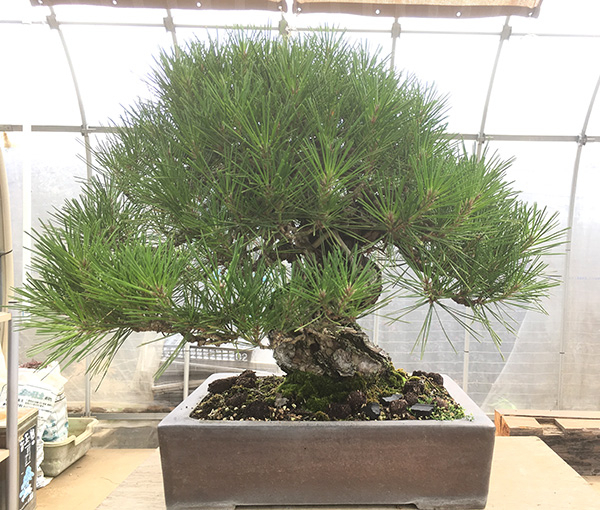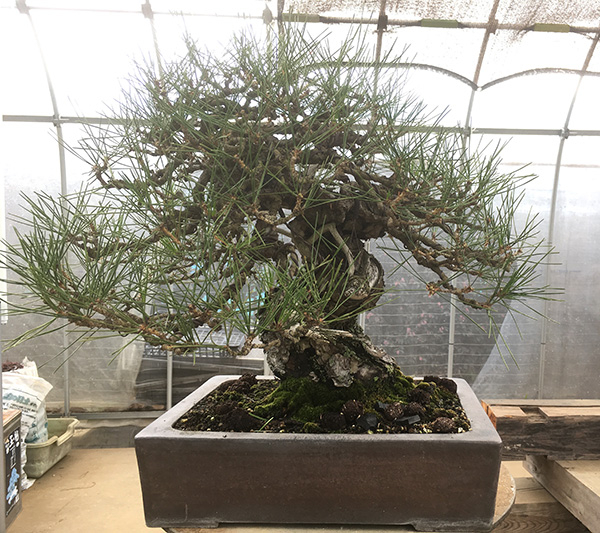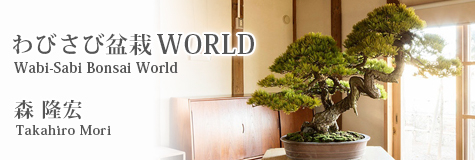
Vol. 5 How to Appreciate Bonsai
June is the time to prune the buds of Japanese red and black pine. The new buds that have grown vigorously since spring are snipped at the border with pine needles from the previous year to encourage more new buds.
Through this approach, new buds and pine needles are shaped to keep them at a length that is less than half the normal size.
The length of the pine needles is very important in bonsai because the desired effect is to evoke the impression of a much larger tree.
In this issue I would like to touch on the points to keep in mind when appreciating bonsai.
Many people likely entertain thoughts and questions such as "That's wonderful"; "Is it alive?"; or "How old is it?" when they observe bonsai.
This was the same impression I had when I first knocked on the gate to a life of training, back when I had as yet no connection with bonsai whatsoever.
One aspect in appreciating bonsai that is different from other decorative plants is to "see the background."
We bonsai masters try to imagine the form of the tree, supported in its small pot, existing within natural surroundings as we work on it.
We imagine the form of a massive tree nestled in the deep forest, or of one on the shoreline bent by the strong sea wind. Or perhaps a stately elder tree planted near human habitation, or one surviving on the challenging environment of a cliff wall. Or even one thriving strongly despite growth stunted by deep snow.
The work of bonsai is the work of understanding the tree's character, bringing out its unique personality, and creating a story for it.
This cannot be understood at first glance. But if you look carefully and long enough, you will likely observe the story of the tree expressed in the miniature world encased in the pot. By allowing your heart to listen to that story, you will begin to see the environment which surrounds it, and perhaps even start to hear the sounds of that environment.
The age of the tree is also a very important point when appreciating bonsai.
The bark of the trunk will speak to you of the tree's history.
The bark of black and red pine is formed from many layers, while that of the five-needle pine (also known as Japanese white pine) is highly detailed. The trunks of maples feature a vertical pattern, while those of the himeshara (Stewartia monadelpha) and Chinese quince typically grow shinier as they age.
The bark of the trunks take on a varying aspect, and this is due not to the skill of the master but to the passage of time.
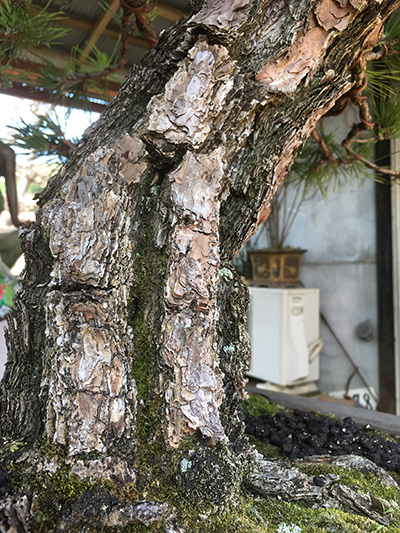
The bark of this black pine describes the great passage of time.
The curve of the trunk and branches expresses the natural surroundings of the tree.
A young trunk that is pressed down under the weight of snow in winter will stretch towards the sky in search of the light during seasons when the snow has melted, forming a unique curve.
In environments where the wind is strong, the branches will all reach in the same direction.
Trees that grow under the competitive conditions of a forest will feature wavy branches that reach outwards seeking light.
The tree's environment can be imagined from its trunk and a single branch, and the bonsai master then gives form to that vision.
Next time you hike in the mountains, closely observe the trees you see around you. You will notice the gentle curves of the trunks and branches as they reach outwards and upwards to seek the light.
Our aim is to recreate this form as close as possible. Thus we too constantly observe with that intention.
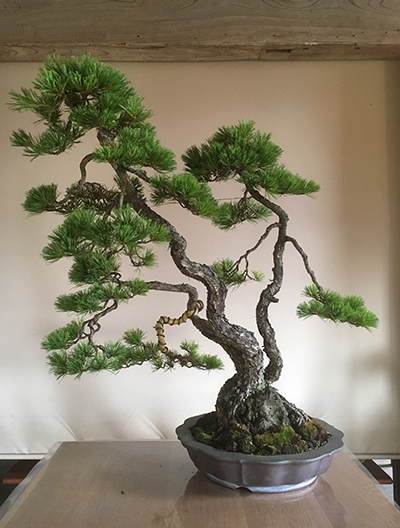
The natural environment gives rise to uniquely curved trunks.
If you look closely at the trunk of a bonsai tree, you will see that the trunk grows steadily narrower from root to top. This is called "koke-jun," meaning "taper," in Japanese, and a good taper is the ideal form for a bonsai trunk.
Even a tree of 20 cm height has its unique taper, painstakingly created over time. This taper is what enables a 20 cm bonsai tree to appear like one that is 10 m tall. This is not possible with a tree that is allowed to grow freely and develop a thick trunk.
At the start of the article I introduced the topic of bud pruning, and this is another point deeply related to the appreciation of bonsai.
For example, if the pine needles on a 20 cm black pine were 10 cm long, the appearance would be unwieldy and the blatant needles would stand out and obscure any sense of background.
Thus trimming the needles to make them small and short is an important factor in evoking the image of a large tree.
For instance, 10 cm black pine can be trimmed down to under 2 cm.
Here I have given several points for appreciating bonsai, but in fact these points are the same elements that we bonsai masters work on to condense the natural environment surrounding the trees within the world of the vase.
The acts of watering the bonsai each day, the seasonal maintenance, protecting them from disease and insects, and spending time with them - as I write this essay, it occurs to me that there is a certain courage in the act of showering these trees, which have no voice of their own, with love through such humble efforts.
Not all the bonsai that await us at the homes of the aficionados we visit for maintenance are great examples of the art. However, the joy and reward they receive from putting love and care into their bonsai is clear from their words, when they say something like, "I've been raising this one for over 40 years since it was a seedling. Its shape won't seem to improve, but I'm fond of it and can't let it go."
So today I continue to wield my scissors with the thought that the life of a bonsai, being taken care of on a daily basis by the bonsai aficionado, is not such a bad one after all.
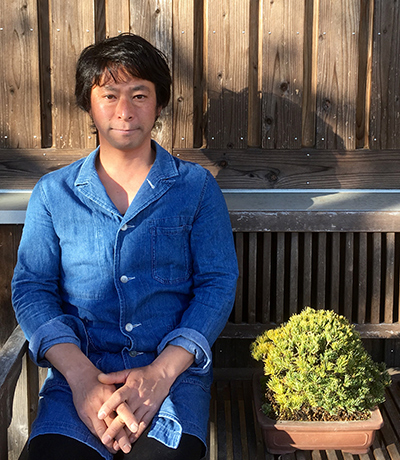 Takahiro Mori
Takahiro Mori
Bonsai master Takahiro Mori was born in Tokyo in 1979. After graduating from the College of Applied International Studies at Tokiwa University, in 2002 he began studying bonsai as an apprentice at Katsuta Koushouen, a bonsai garden in Ibaraki Prefecture. In 2006, he became independent and launched his own activities. In 2009, one of his works won the Kokufu Award at the Kokufu-ten Bonsai Exhibition, an event with a long and distinguished history. From 2009 to 2013, he worked as an in-house bonsai artist at the Omiya Bonsai Art Museum, Saitama. In 2013, he traveled to Kosice in Slovenia, the European Capital of Culture 2013, as a bonsai demonstrator, and participated as a representative of bonsai masters in the presentation for Saitama's bidding to host the 8th World Bonsai Convention, which will be held in 2017. Mori conducted demonstrations at Bonsai Slovakia 2014, and participated as a bonsai expert in the Japan Government exhibit at the EXPO 2016 Antalya International Horticultural Exposition held in Turkey in 2016. Today, in addition to his work as a bonsai master, Mori is actively engaged in initiatives to promote the art of bonsai in Japan and abroad through workshops for beginners that he conducts at his atelier Bonsai Mori established in 2013 and bonsai classes he organizes in California in the United States.
Bonsai Mori website http://bonsaimori.jp/
Bonsai Mori Facebook https://www.facebook.com/Bonsaimori/
Related Articles
Keywords
Back Issues
- 2022.7.27 Beyond Disasters - T…
- 2022.6.20 Beyond Disasters - T…
- 2021.6. 7 Contributed Article …
- 2021.4.28 Crossing Borders, En…
- 2021.4.27 Contributed Article …
- 2021.4.20 Contributed Article …
- 2021.3.29 Contributed Article …
- 2020.12.22 Interview with the R…
- 2020.12.21 Interview with the R…
- 2020.11.13 Interview with the R…


